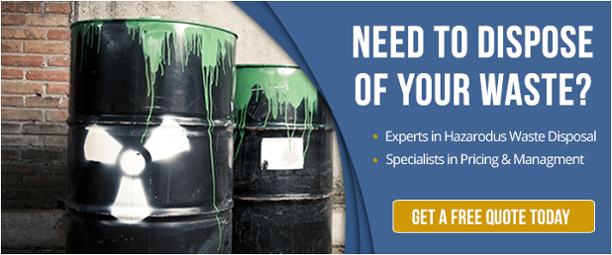Waste that isn’t deemed as “hazardous” can still pose a threat, which is why proper disposal of any waste is important.
And, while the federal government may designate one type of waste as non-hazardous, a state may designate it as hazardous.
In other words, though the name “non-hazardous waste” implies that it doesn’t pose a threat to humans or the environment, it’s not always that clear-cut. In fact, materials can be hazardous even if they are not listed by California code as a hazardous waste or do not exhibit hazardous waste characteristics.
That means, disposal of any type of waste can prove problematic if it’s not done properly.
If your facility produces waste, here’s what you need to know about how to dispose of non-hazardous waste and the assistance that is available to ensure you are meeting all state and federal regulations.
Identify The Waste
 Before you can determine how to dispose of the non-hazardous waste your facility generates, you must first be able to identify it.
Before you can determine how to dispose of the non-hazardous waste your facility generates, you must first be able to identify it.
Certain types of non-hazardous waste is easy to identify. For example, the U.S. Environmental Protection Agency defines non-hazardous industrial waste as “waste generated from processes associated with the production of goods and products, such as electric power generation and manufacturing of materials such as pulp and paper, iron and steel, glass and concrete.”
However, other types of waste such as non-medical waste or chemical waste may be more difficult to distinguish as being non-hazardous versus hazardous. In situations like these, it is important to work with a reputable disposal company who will identify wastes through sampling and testing.
A disposal company can then certify the waste as non-hazardous, ensuring you don’t run into any trouble with the authorities during disposal.
Check Laws To Determine If Hazardous
If your company produces any kind of potentially hazardous waste, it is critical to be able to differentiate between non-hazardous waste versus non-RCRA hazardous waste.
RCRA is the Resource Conservation and Recovery Act, a federal public law that oversees the management of both hazardous and non-hazardous waste.
Waste can be considered hazardous, but not fall under the same federal RCRA guidelines for disposal. Furthermore, while one type of waste may be considered non-RCRA hazardous waste, it may fall under more strict hazardous waste state laws.
For example, one of the only types of e-waste disposal that is restricted under the RCRA is the disposal of cathode ray tubes (CRTs), which are typically found in TVs and computer monitors. CRTs are considered hazardous waste because of the hazardous materials inside, including lead, cadmium and barium.
However, in California, the Department of Toxic Substances Control requires that several more electronics be disposed of as hazardous waste. These include common items like cell phones, radios and computers.
Take Waste To A Disposal Site
 If you have determined your waste is non-hazardous, you may be able to simply take it to a Treatment, Storage and Disposal facility (TSDF) or landfill. However, it is important that you check with the disposal facility first to determine not only whether it will accept your waste, but the quantity as well.
If you have determined your waste is non-hazardous, you may be able to simply take it to a Treatment, Storage and Disposal facility (TSDF) or landfill. However, it is important that you check with the disposal facility first to determine not only whether it will accept your waste, but the quantity as well.
Some facilities limit the amount of waste you can drop off at one time, and instead require that a disposal company transfer large amounts of waste from your facility to the landfill.
If your waste is in a small quantity, you may be able to discard it into the trash receptacle on your property. However, if you have bulk amounts, you may need to contact a disposal company for transfer.
Reuse Or Recycle
The EPA’s Sustainable Materials Management effort places an emphasis on reusing secondary materials considered non-hazardous.
Often these secondary materials are scraps and residuals that result from the production process. However, they can often be just as valuable.
For example, coal combustion residuals that are generated by steam electric utilities can then be used as valuable resources in other industries.
This often occurs when the reusable materials can be used as substitutes for an original material since they retain the same physical and chemical properties.
Depending on the type of non-hazardous waste your facility produces, a recycling facility may accept it as well. CalRecycle, California’s recycling and waste management program, oversees the recycling of several types of waste that businesses and facilities produce. This includes materials like electronic waste, paint, organic material and beverage containers.
Get Assistance
For the above reasons, it’s important to work with a certified waste disposal company that can help you identify your waste and determine which laws must be followed for proper disposal.
In addition to the EPA, state and local governments often regulate non-hazardous waste, which is why you should consult with a local non-hazardous waste disposal company to ensure your waste is properly identified and disposed of according to all appropriate regulations.
It’s important to remember that as the company that is generating the waste, it is your responsibility to determine whether your waste is hazardous or non-hazardous. Even once that is determined, it is still your responsibility to ensure the waste is legally and safely disposed of.
Our article, Examples Of Non-Hazardous Industrial Waste, further explores common examples of non-hazardous waste and their benefits to a company when properly discarded or recycled.


Comment